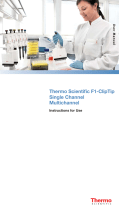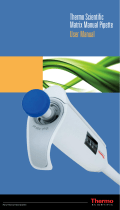20
H
A
B
S
R
Automated Dispensing
Automated Dispensing dispenses aliquots automatically, in timed intervals, in
Multi-Dispensing mode. The user does not need to press the operating button
each time liquid is dispensed. The dispensing interval can be set from 0,1 to
9,9 seconds.
To set the interval:
1. Turn the adjustment wheel to set the interval immediately after the
advanced function has been activated.
2. Confirm by pressing the operating button or the right Softkey for OK.
Fast Dispensing
Fast Dispensing can only be used in Titration mode. In Fast Dispensing, the
first selected portion of the total volume is dispensed automatically, and the
remaining volume is dispensed manually.
To set the volume for Fast Dispensing:
1. Turn the adjustment wheel to set the desired volume immediately after
the advanced function has been activated.
2. Confirm by pressing the operating button or the right Softkey for OK.
Repeated Blow-out (only in Picus® NxT)
Repeated Blow-out allows the user to activate and repeat the blowout of
remaining liquid droplets, for dispensing liquids that would normally leave
a residue in the tip. Repeated Blow-out is available with Pipetting, Manual
Pipetting, Diluting, and Multi-Aspiration modes.
To activate/deactivate Blow-out:
1. Start your chosen main mode.
2. Once the pipetting cycle has ended, you may repeat the blowout by
pressing the operating button as many times as necessary.
3. To exit Blow-out, turn the adjustment wheel or eject the tip by pressing
the tip ejector button.
3.3. Saving Pipetting Programs to Memory
All Picus® and Picus® NxT models allow 10 programs to be saved in the pipette
memory. In the Picus® NxT, sequences of pipetting modes can be stored as
protocols (see section 3.2.9).
To save a program:
1. Choose the pipetting mode and edit the settings (see previous section),
then press the Hotkey (H) to see available memory places.
2. Choose a memory place by turning the adjustment wheel (A).
3. Press the middle Softkey for SAVE (S).
a. In Picus® NxT models, if the password feature has been activated, only
the administrator profile can save programs.
4. Next the pipette asks for a name for the memory place. Activate the name
editor by pressing the operating button (B).
5. With the middle Softkey (S) you can switch between characters, numbers
and symbols. Turn the adjustment wheel (A) to change the characters and
press the operating button (B) or the right Softkey (R) for OK to confirm
the selection and to move on to the next character. If you want to cancel
the character change, you can press the left Softkey for BACK.
6. Repeat the sequence for all characters. Confirm the last character with OK
or the operating button, and the pipette will exit the editing mode.
7. If you want to clear any of the characters in the name, turn the
adjustment wheel until the character is underlined and press the right
Softkey for CLEAR. Repeat this until the desired characters are cleared.
8. Save the program name by pressing the middle Softkey for SAVE (S) and
the pipette will return to the list of memory places.
9. If you wish to exit without saving the latest change, press the left Softkey
for BACK at any time.
M10 indicates that the pipetting program
shown has been saved in memory place 10.
To exit Blow-out, turn the adjustment
wheel or eject the tip by pressing the tip
ejector button.























